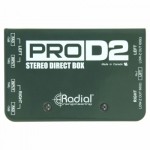The DI box (for direct injection or direct input), also known as a direct box, is a device who’s main basic function is to convert the unbalanced high-impedance output of an instrument’s signal into a balanced low impedance one, which in turn allows longer cable runs without adding noise, among other benefits. In their most basic setup, DIs are usually equipped with at least one input and two outputs; one being a through-put for an instrument amplifier and the other for input to a PA system. The second of those outputs works through an XLR connection which also allows it to be connected to the microphone inputs of a mixer. Today, we're going to look at a little bit of history along with the differences between the two types of DI boxes -- active and passive.
History of the DI Box
During the 1970s as venues became larger and touring equipment became more powerful and complex, the DI box was essentially created as a means to isolate a musician’s stage amplifier from the PA, thereby eliminating that well-known AC hum. As mentioned above, they allowed longer cables to be used without damaging a signal’s integrity by lowering impedance and keeping that signal balanced. During these simpler times – and like most music gear at the time – DI’s were all passive and essentially a transformer in a little box which wasn’t so bad until it was discovered that these passive boxes were having a negative effect on the sound of certain instruments – most notably single-coil Fender basses. Not until the ‘80s did the active DI box come about, which if you are not familiar with the terms active and passive when it comes to things such as pickups, microphones, and preamps, means that they needed an extra power source to get going – specifically a battery of phantom power. Alright, now let’s take a closer look at each of the two to get a better understanding of what each can bring to your sonic table, beginning with…
Active DI Boxes
Active direct boxes are in fact preamplifiers, whose primary function is to provide higher input impedance than that of a transformer to drive instruments with low-level signals. For example, if you were using a passive DI to send an old Fender bass to the console, its single-coil pickup had to drive an amplifier, transformer, mic-splitter transformer, and a few hundred feet of cable. The result would be a lack of punch and clarity due to the excessive loading of the pickup. This is not to say that all passive DIs sound bad. Remember, the application plays a large role. Another reason for sound quality issues with passive DIs in the past was that cheap transformers were being used to keep prices down. Unfortunately, poorly designed transformers can cause ringing and smearing of the upper frequencies, or a reduction of sound quality in general. Active DIs were created as a means of improving sound quality while keeping costs down. They did so by providing enough gain to drive the aforementioned Fender bass without adversely loading the instrument’s pickup. The tradeoff with active devices is the loss of ground isolation.
Active DIs can take their power from batteries, which is less desirable to professional touring FOH (Front of House) engineers, or phantom power coming off the mixer (more desirable). Active DIs, being much like preamps, also have features including pads, ground-lift switches, high-pass-filters, polarity reverse, and equalization switches. Alright, let’s move on to…
Passive DI Boxes
As we stated earlier, a direct box is basically a transformer. It acts as a bridge between input and output by virtue of electromagnetic induction. In essence, the signal is passed through a shared magnetic field. Since there’s no hard wiring, the signal is electronically isolated from input to output. As a result, 60-cycle hum from ground loops and DC noise are eliminated. The word “passive” means that the unit does not require power in order to operate. Another advantage of transformers is that they don’t distort the way active circuits do when they are driven into overload. With active circuits, it’s all or nothing. Once overdriven, they abruptly go from clean to completely distorted and harsh, whereas transformers saturate, thus presenting a smooth transition that mimics the behavior of a limiter. On the downside, transformers aren’t particularly good at handling low-output instruments, such as old electric guitars, basses, and vintage keyboards, since there is no power to drive a weak signal. On the upside, along with hum-eliminating abilities, passive DIs are good at handling high-output instruments (anything with a battery-powered preamp, for example).
Hopefully, the information above has given you a good grasp of what the DI is all about. If you need to add a DI box to your setup, you should definitely check out our DI section by using the link below! And if you have any questions regarding what type of DI box is good for your personal setup or any questions regarding a purchase, don't hesitate to contact one of our knowledgeable PAL pros by using the Contact Us dialogue box below!
Your Turn to Sound Off!
Do you use a DI box with your setup? If so, which one?
Let us know in the comment section below!

